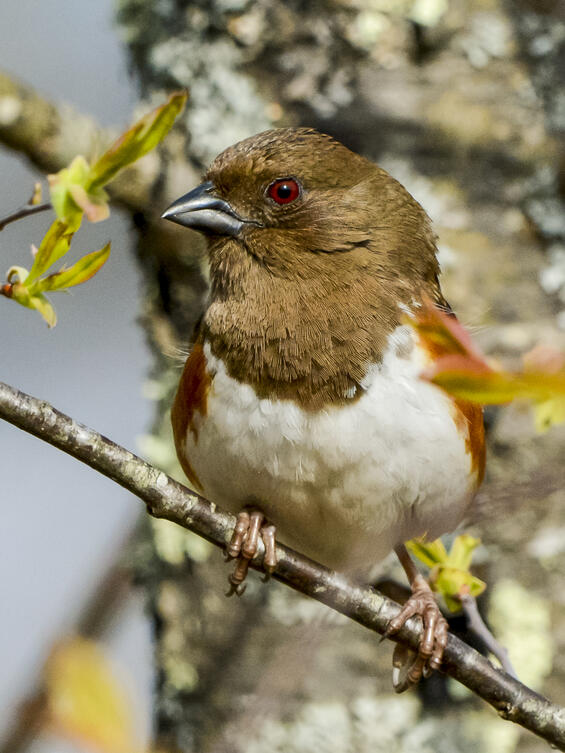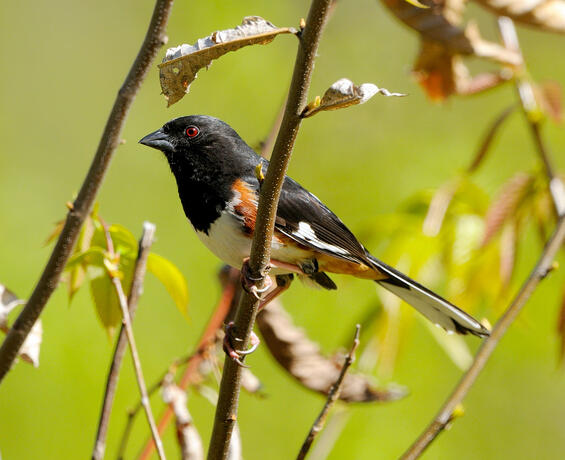- Scientific name: Pipilo erythrophthalmus
Species of Greatest Conservation Need (MA State Wildlife Action Plan)
Description

Eastern Towhee (Pipilo erythrophthalmus)
The eastern towhee is a medium sized songbird and shows sexual dimorphism. The male has a dramatic plumage with a black hood and wings whereas the female has a more cryptic brown plumage. Both sexes have a long tail with white corners at the tips, and a white patch on the wing. Common vocalizations of the species includes their song of “drink your teeeee” and call note “tow-hee” from which they get their name.
Life cycle and behavior
Eastern towhees begin breeding in Massachusetts in mid-May and conclude in mid to late July. They typically produce one brood per year in Massachusetts, which is less than the two or even three broods they produce in southern United States. Nests are built by females either on the ground or in low shrubs, often concealed by dense vegetation. A typical clutch consists of 2-6 eggs, which are incubated for 12-13 days. Once hatched, nestlings remain in the nest for 10 to 12 days before fledging. During this period, both parents participate in feeding the young, providing a diet rich in insects, spiders, and other small invertebrates. Eastern towhees are primarily ground foragers, using a characteristic bilateral scratching technique—hopping forward and then thrusting both feet backward to uncover hidden prey such as invertebrates and seeds. This scratching behavior is most frequent during fall and winter when food sources are less abundant. Eastern towhees begin their southward migration in late September to early October, with peak movement occurring in October and November. Eastern towhees are nocturnal migrants.

Population status
The eastern towhee has experienced significant population declines across its range, including Massachusetts. According to the North American Breeding Bird Survey, eastern towhee range-wide populations declined by an estimated 1.4% per year, resulting in a cumulative decline of about 53% between 1966 and 2019. The species has undergone some of its steepest declines in Massachusetts and throughout New England.
Distribution and abundance

Eastern Towhee (Pipilo erythrophthalmus)
The eastern towhee breeds throughout the eastern United States into southern Ontario and is considered a short-distance migrant in the northern reaches of its range. The northern limit of its winter habitat is generally from the mid-Atlantic States west through Ohio, though annually some individuals will attempt to winter in southern New England. In Massachusetts, eastern towhees are most numerous in the scrub-oak and second-growth forests of Plymouth County, Cape Cod, and the Islands. They particularly favor areas where moorland is succeeding to scrub-oak barrens; however, as the oaks mature, towhee numbers decline. Elsewhere the species is found throughout the state wherever there is secondary growth or forest openings.
Habitat
The eastern towhee is an edge-associated generalist that occupies varied mesic and xeric habitats characterized by dense shrub-small tree cover and a well-developed litter layer. This species occupies mid-to-late stages of secondary succession with the greatest densities occurring in open field thickets and later stages of second growth, but it is sometimes present in climax forest where the understory is well developed.
Healthy habitats are vital for supporting native wildlife and plants. Explore habitats and learn about conservation and restoration in Massachusetts.
Threats
The major threat to eastern towhee populations in Massachusetts is loss of suitable habitat due to landscape conversion and succession. Though shrubland birds as a group do not appear to be as sensitive to patch-size as other groups of birds, the indirect effects of suburban sprawl can be important through the magnified risks on ground nests from predation (domestic cats, raccoons, jays) and cowbird parasitism. Predation by domestic cats has been identified as the largest source of mortality for wild birds in the United States with the number of estimated mortalities exceeding 2 billion annually. Cats are especially a threat to those species that nest on or near the ground.
An additional threat to the species is collisions with buildings and other structures, as approximately 1 billion birds in the United States are estimated to die annually from building collisions. A high percentage of these collisions occur during the migratory periods when birds fly long distances between their wintering and breeding grounds. Light pollution exacerbates this threat for nocturnal migrants as it can disrupt their navigational capabilities and lure them into urban areas, increasing the risk of collisions or exhaustion from circling lit structures or areas.
Conservation
Management for eastern towhee should seek to maintain habitat diversity in the region; specifically to increase the array of woody plant communities in mid-seral stages of secondary succession. Steps must also be taken to preserve blocks of pine barrens where major concentrations of the species persist. In pine barrens and oak scrub associations, fire is an important management tool. Towhees benefit from controlled burning, but the frequency of burns must be considered. Managing utility rights-of-way has enormous potential for increasing habitat availability for shrubland birds and capitalizing on these already existing and essentially permanent shrublands should be encouraged whenever possible. In landscapes that are primarily forested, early successional forest patches should be included in rotational forest management where several small and several large early successional patches are rotated through the forest matrix. Where suitable habitat currently exists, efforts should be made to protect the landscape from development.
Promote responsible pet ownership that supports wildlife and pet health by keeping cats indoors and encouraging others to follow guidelines found at fishwildlife.org.
Bird collision mortalities can be minimized by making glass more visible to birds. This includes using bird-safe glass in new construction and retrofitting existing glass (e.g., screens, window decals) to make it bird-friendly and reducing artificial lighting around buildings (e.g., Lights Out Programs, utilizing down shielding lights) that attract birds during their nocturnal migration.
References
Askins, R. R. Restoring North American Birds. New Haven, CT: Yale University, 2000.
Greenlaw, J. S. (2020). Eastern Towhee (Pipilo erythrophthalmus), version 1.0. In Birds of the World (P. G. Rodewald, Editor). Cornell Lab of Ornithology, Ithaca, NY, USA. https://doi.org/10.2173/bow.eastow.01
Sauer, J.R., J.E. Hines, J.E. Fallon, K.L. Pardieck, D.J. Ziolkowski, Jr., and W.A. Link. 2022. The North American Breeding Bird Survey, Results and Analysis 1966 - 2022. Version 01.30.2015 USGS Patuxent Wildlife Research Center, Laurel, MD.
Veit, R., and W.R. Petersen. Birds of Massachusetts. Lincoln, MA: Massachusetts Audubon Society, 1993.
Contact
| Date published: | May 15, 2025 |
|---|